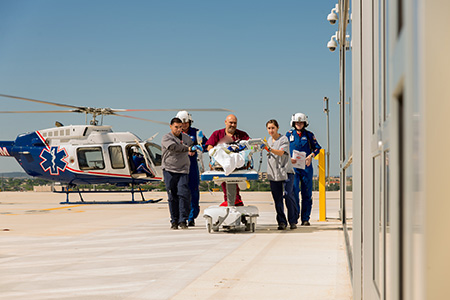Department of Emergency Health Sciences trains Army, National Guard and Army Reserve flight paramedics

Several years ago, an Army colonel and physician approached the Department of Emergency Health Sciences about conducting a pilot program to train Army flight medics as paramedics, whose more rigorous training research had shown meant better outcomes for injured soldiers.
Conducted in 2012, the pilot program was a success and resulted in a five-year, $8.3 million contract to provide paramedic and critical care transport training to all flight medics in the Army, National Guard, and Army Reserve, said Associate Professor and Emergency Health Sciences chair, Lance Villers.
Paramedics receive specialized training beyond that of emergency medical technicians, Villers said, including advanced airway techniques and surgical procedures, as well as training to give a wider range of medications.
“These are flying ICUs, with the added challenges of gunfire and battlefield conditions,” Villers said of the helicopters transporting wounded soldiers. “One of the additional personnel in the back of a Blackhawk is there with a weapon to provide protection for the medics who are running into the scene.”
Now in its fifth year, the program has trained hundreds of flight paramedics, who come to San Antonio for nine months of training. The program will welcome its 25th cohort in February. Each cohort has about 25 to 30 students.
The program is divided into two phases, beginning with a 7-month, full-time paramedic training course, which prepares students for the national paramedic certification exam. Upon passing that exam, students begin a 9-week critical care transport training program and prepare for the national flight paramedic examination.
The paramedic training curriculum is the same one the Department uses to train San Antonio Fire Department paramedics. Villers noted that soldiers leave the program with training that will serve them beyond their military service.
“They have a civilian credential that will help them get a job right away—and they have some extremely valuable real-world experience,” he said.
Members of the National Guard and Army Reserve take their training back to their communities and are able to respond at a high level in natural disasters, Villers added.
“Our faculty knows that they are making a difference, and there is no better student to have than a student who immediately recognizes the relevance of what they are being taught,” he said. “They are coming here eager to learn this knowledge and learn this new skill set and be able to immediately apply it and use it in the real world. They know they are going to be able to save the life of their fellow soldier.”